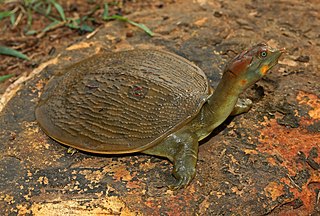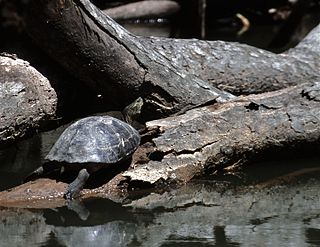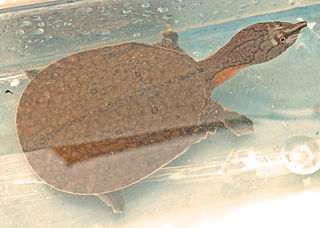
The yellow-spotted Amazon river turtle, also known commonly as the yellow-headed sideneck turtle and the yellow-spotted river turtle, and locally as the taricaya, is one of the largest South American river turtles.

The Indian narrow-headed softshell turtle, also known as the small-headed softshell turtle or the Indo-Gangetic softshell turtle, is an endangered species of softshell turtle native to waterways and rivers of the Indian subcontinent. It is very large, feeding on fish, frogs, worms, crustaceans and molluscs, and even the occasional swimming small rodent or other mammal. C. indica, like other softshell turtles, uses it flexible shell to dig itself deep into sandy lake and river bottoms; here, it patiently waits for potential prey to swim by. They will also ambush and chase their prey, depending on availability, the time of year, and size of the prey. In the past it was included as a subspecies of Chitra chitra, a species restricted to Southeast Asia using current taxonomy.

The Asian giant softshell turtle, also known commonly as Cantor's giant softshell turtle and the frog-faced softshell turtle, is a species of freshwater turtle in the family Trionychidae. The species is native to Southeast Asia. The species is critically endangered and in the 20th century has disappeared from much of its former range.

Leith's softshell turtle is a species of turtle in the family Trionychidae. The species is found in peninsular Indian rivers including the Thungabhadra, Ghataprabha, Bhavani, Godavari, Kaveri and Moyar Rivers. The type locality is Pune in India.

Chitra is a genus of turtles in the family Trionychidae.

The northern river terrapin is a species of riverine turtle native to Southeast Asia. It has been classified as Critically Endangered on the IUCN Red List and considered extinct in much of its former range; as of 2018, the population in the wild was estimated at 100 mature individuals.

The wattle-necked softshell turtle, also commonly known as Steindachner's soft-shelled turtle, is an endangered Asian species of softshell turtle in the family Trionychidae. The species is the only member of the genus Palea.

Pelochelys is a genus of very large softshell turtles in the family Trionychidae. They are found from peninsular India northeast to southern China, and south to Southeast Asia and New Guinea.

The yellow-headed temple turtle is a large species of turtle in the family Geoemydidae. The species is native to Southeast Asia.

The Cuatro Ciénegas softshell, also called the black spiny softshell, is a subspecies of the spiny softshell turtle in the family Trionychidae. It is found only in the Cuatro Ciénegas Basin in the Mexican state of Coahuila and it is considered critically endangered by the IUCN. The subspecies, along with its parent species, was formerly classified in the genus Trionyx.

The Malayan softshell turtle is a species of softshell turtle in the family Trionychidae. It is monotypic in its genus.

Nilssonia is a genus of softshell turtles from rivers, streams, ponds, and lakes in South Asia and Burma. In many treatments, it is monotypic, with the single species Burmese peacock softshell. However, the supposed other genus of peacock softshells, Aspideretes, is more closely related to N. formosa than had been believed. They differ only in the neural plates between the first pleural scale pair of the bony carapace, which are fused into one in N. formosa and unfused in the others.
The southern New Guinea giant softshell turtle is a species of softshell turtle in the family Trionychidae. The species is endemic to the lowlands of southern New Guinea with occasional vagrant individuals sighted off the coast of northern Australia. P. bibroni is referred to by the Suki people as kiya eise, a reference to its flexible shell. In the Arammba language, it is called sokrere, meaning "earthquake". It is sometimes hunted by local villages for its meat and/or eggs, leading to some cases of chelonitoxism.

Parker's snake-necked turtle is a species of turtle in the family Chelidae.

The East African black mud turtle, also known as the Pan terrapin, is a species of turtle in the family Pelomedusidae, native to eastern and southeastern Africa.

The African softshell turtle, or Nile softshell turtle, is a large species of softshell turtle from freshwater and brackish-water habitats in Africa and the Near East. It is the only extant species in the genus Trionyx; historically, despite other species having been formerly placed in this genus as well, they have all been reclassified to other genera. Despite the common name of "African softshell turtle", Trionyx triunguis is not the sole species of softshell turtle found in Africa—the generas Cyclanorbis and Cycloderma are African—nor is it solely found on that continent, alone. T. triunguis is a very large species of softshell turtle, with sizes ranging from 85 to 94 cm, with a weight of 40 kg, and an unconfirmed max size of 120 cm. They are omnivorous in their diet, consuming not only small fish, frogs, tadpoles and crustaceans, but also floating palm seeds and fallen leaves, and some aquatic vegetation.

The Assam leaf turtle is a species of turtle in the family Geoemydidae. The species is native to India, Nepal, Bhutan, and Bangladesh.

The Myanmar brown leaf turtle is a species of Asian leaf turtle found in Myanmar.

The Malayan snail-eating turtle is a species of turtle in Malayemys genus of the family Geoemydidae.

The Southeast Asian softshell turtle is a species of softshell turtle in the family Trionychidae.



















